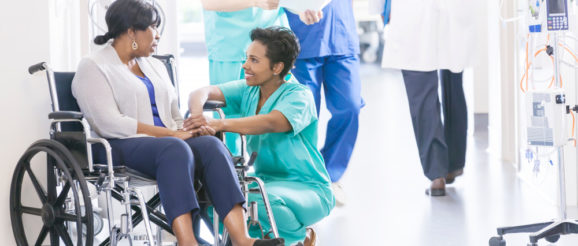Powering the Patient Experience with Invaluable Tech Innovation

Introduction
Technology is often at the heart of improving the human experience. According to a recent study completed by Online Medical Care, 53% of people who use health monitors or wearable fitness trackers say they share that data with their doctor. From changing how we move about the world to how we communicate, and most recently how we can leverage data to improve so many practices and processes, technology shapes our lives. Nowhere is the positive impact of technology more readily apparent than in healthcare. The ability to treat more patients, save lives and, most importantly, cure previously incurable diseases has been at the heart of innovation in the field.
While healthcare IT clearly improves patient outcomes and reduce the burden on the clinician it also presents an opportunity to decrease barriers between the patient and caregiver. Putting the patient and physician back at the center of a healthcare encounter complemented by technology is an area that Alexandra Valentin, Practice Director at The Ritz-Carlton Leadership Center, counsels and guides healthcare organizations on as they embark on transformative journeys for both patients and clinicians.
“There has been an explosion in healthcare IT over the last several years,” said Valentin. “From Electronic Medical Records (EMRs) to virtual care and telehealth, these new innovations in healthcare have brought convenience to both the patient and provider that have transformed the overall healthcare experience.” For providers, these new tools may result in them unintentionally spending more time entering data or checking digital devices to access vital care information instead of fully connecting with the patient so it’s imperative that providers maintain a balance of connecting the human and the digital each day when it comes to the overall patient experience.
Cleveland Clinic Focuses on Empathy and Innovation
What Valentin sees among a growing number of healthcare providers is an awareness that technology needs to be integrated and managed to deliver an optimal patient experience. The recent HIMSS Empathy and Innovation Conference was focused on the issue of patience experience in a tech-fueled era and providers were eager to share experiences and learn from one another.
As Adrienne Boissy, MD, MA, Chief Experience Officer at the Cleveland Clinic shared in the lead up to the event: “Patient experience needs to become a priority for organizations and most healthcare organizations are making it a priority…but there’s still a lot of work to be done. Patients are still telling us that access [and] communications still aren’t right; it’s still too difficult.” Boissy’s colleague at the Cleveland Clinic, Lori Kandas, Executive Director of Patient Experience, added “if we’re putting it [tech] in their hand or in front of them, is it helping their journey, is it making it seamless, and are we staying connected [with the patient].”
Redefining the Patience Experience with Technology & Education on Innovation
For Valentin, delivering a high-quality patient experience starts with putting not only the patient and the provider at the center of the care experience, but also invaluable tech innovation.
“From receiving an automated text message reminder or email to book a preventative care appointment, to booking an appointment online with a primary care physician and ultimately the actual bedside manner, a patient needs to feel cared for – both virtually and in person.” Valentin emphasized. “Healthcare systems are evolving their training curriculum to educate caregivers how to use a tablet not because it’s in their hands, but because they can access more data about the patient to provide more insight on their health. These are the foundations to building a high-quality patient experience in a tech-fueled era.”
While one of the key roles for technology in healthcare is to deliver better care more quickly, Valentin noted that as insurers drive healthcare towards value-based care, technology has an important role here too. With preventative care becoming as important as curative care, the use of home-based, or personalized health technology, is on the rise, but here too, caregivers need to put the technology in the context of human connection. “Being able to monitor blood pressure or blood sugar levels from home and communicated via WIFI to the doctor’s office is a real benefit for preventative care,” said Valentin. “These benefits will be exercised most effectively if the patient doesn’t feel overwhelmed or frustrated by the technology and they feel they are supported by their care team.”
Valentin’s suggestion for how to help patients adapt to these opportunities is to flip traditional healthcare relationships. “It’s common practice in the medical community for caregivers to have ‘lunch and learn’ events with equipment suppliers and pharmaceutical companies. They could replicate this model with their patients to build rapport and relationships while integrating personalized health technology into their care. By focusing on how these tools contribute to wellness and meeting with their patients regularly in a group setting, there’s the opportunity to reduce the number of office visits and build a healthier practice population over time,” she offered.
Conclusion
What’s clear from listening to experts like Valentin, Boissy, and Kandas, is that technology is an integral part of patient care. When patients are put at the center and technology is integrated to support the caregiver to improve the human connection and the delivery of care then it is transformative tool. “Each patient is unique and technology provides a tremendous opportunity to enhance their care experience and ultimately their overall health,” Valentin concluded.
The post Powering the Patient Experience with Invaluable Tech Innovation appeared first on Future Healthcare Today.
